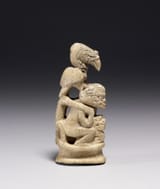Search Results
7/18/2025, 6:01:47 PM
>>96120757
Second idea: museum websites. For example:
https://art.thewalters.org/browse/place/
I tried "Colombia"
https://art.thewalters.org/object/48.2845/
>Along with figurines, flutes and whistles were one of the most common artifacts made by ancient Pre-Columbian artists, and they are found in every culture, from the earliest times. This Tairona example closely resembles objects of other mediums (like gold), which are not whistles and depict winged figures. Such whistles are still used among the Kogi people of Colombia, who descended from the Tairona, and the wing forms may refer to shamanic flight.
The Shaman whistles his spells instead of speaking magical words? Ocarina instead of wand? Ornamental wing-like ornaments identify his magical prowess?
https://art.thewalters.org/object/2006.15.1/
>carved bone finial likely once graced the head of a ritual staff-like implement of a shaman.
Neat staff for a start.
>Throughout Middle America vultures are commonly affiliated with the celestial realm; jaguars with the terrestrial realm; and serpents with the watery underworld.
Vultures being associated with necromancy might make sense for us, but not this culture.
>The shaman's slightly simian nose and exaggerated grimace mark his altered trace-state; in effect, he has achieved a hyper-real, 'super'-natural state, and thus is prepared to communicate directly with the otherworldly spirit representatives of the earth, sky, and underworld.
Casting spells requires one to transmute into a caricature-like/symbolic-like state? Partially spiritual for a little time?
Second idea: museum websites. For example:
https://art.thewalters.org/browse/place/
I tried "Colombia"
https://art.thewalters.org/object/48.2845/
>Along with figurines, flutes and whistles were one of the most common artifacts made by ancient Pre-Columbian artists, and they are found in every culture, from the earliest times. This Tairona example closely resembles objects of other mediums (like gold), which are not whistles and depict winged figures. Such whistles are still used among the Kogi people of Colombia, who descended from the Tairona, and the wing forms may refer to shamanic flight.
The Shaman whistles his spells instead of speaking magical words? Ocarina instead of wand? Ornamental wing-like ornaments identify his magical prowess?
https://art.thewalters.org/object/2006.15.1/
>carved bone finial likely once graced the head of a ritual staff-like implement of a shaman.
Neat staff for a start.
>Throughout Middle America vultures are commonly affiliated with the celestial realm; jaguars with the terrestrial realm; and serpents with the watery underworld.
Vultures being associated with necromancy might make sense for us, but not this culture.
>The shaman's slightly simian nose and exaggerated grimace mark his altered trace-state; in effect, he has achieved a hyper-real, 'super'-natural state, and thus is prepared to communicate directly with the otherworldly spirit representatives of the earth, sky, and underworld.
Casting spells requires one to transmute into a caricature-like/symbolic-like state? Partially spiritual for a little time?
Page 1
